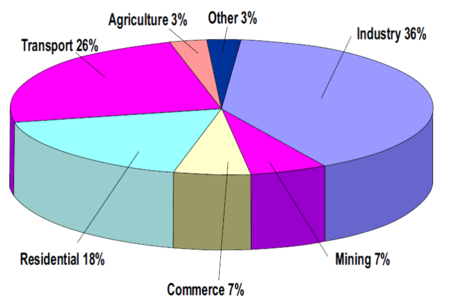Click here to register!
South Africa Energy Situation
| South Africa | |||
|---|---|---|---|
| Capital | Pretoria | ||
| Official Languages(s) |
11 Official languages with Zulu being the most spoken language | ||
| Political Stability | Democratic Republic | ||
| Climate Zone | Tropical (Tropical wet and dry) | ||
| Temperature Range (⁰C) | 25°C is the average temperature during Summers(November to March) and 10°C is the average lowest temperature during winters(June to August) | ||
| Altitude(s) (m above MSL) | Lowest altitude is 0 m(Sea level) and highest is 3450m | ||
| Government | |||
| President | Jacob Zuma[1] | ||
| 'Total Area '( km²) | 1211037[2] | ||
| Population | 52981991[3] | ||
| Rural Population | (year) | ||
| GDP (Nominal) | US $ 471178 Billion (2011)[4] | ||
| GDP Per Capita | US $ (year) | ||
| Currency | Rand | ||
| Time Zone | UTC/GMT +2 hours | ||
| Electricity Generation | TWh/year (year) | ||
| Access to Electricity | 75 % | ||
| Wind energy (installed capacity) | MW (year) | ||
| Solar Energy (installed capacity) | MW (year) | ||
| Literacy Rate | 89 % | ||
| South African currency against Euro | 1 Euro ~ 11 South African Rand (ZAR)
| ||
|
Government and Public Authorities (having Jurisdiction)
|
NERSA ( National energy regulator of South Africa) DoE (Department of Energy) DWEA (Department of water and Environmental affairs) | ||
| Institutes (research etc) |
SABS (South Africa Bureau of Standards) SANEDI ( South Africa National Energy Development Institute) SANERI (South Africa National Energy Research Institute) | ||
| Usable land area for PV ( km²) | 1062665(87% of Total land Area) | ||
| Seismic activity | The south-western Cape has one of the highest levels of seismicity in South Africa.Historically, the most severe earthquake of magnitude 6.3 occurred on 29 September 1969 in Ceres, 100 km northeast of Cape Town. The event resulted in 12 lost lives and numerous damaged buildings in the town of Tulbagh. On 4 September 1809, a seismic event estimated at magnitude 6.3, occurred at the Milnerton Fault, a mere 10km from Cape Town CBD and the location of the Cape Town Stadium. | ||
Overview

Economy General
- 1 Euro ~ 11 south African Rand (ZAR).
- GDP ~ 3080 Billion ZAR ~ 280 Billion Euro.
- Exports amounted to 24% of GDP in 2010.
- Large and active stock exchange that ranks 17th in the world.[6]
- Active member of BRICS
- BRICS is an international political organisation of leading emerging economies with a developing middle income status and it comprises of Brazil, Russia, India, China and South Africa.
Hydropower
Till date hydropower contributes only 0.1% of the South African Energy supply.[7]
The Baseline Study on Hydropower in South Africa, an assessment conducted by the DME in 2002, indicated that specific areas in the country show significant potential for the development of all categories of hydropower in the short and medium term.
The Eastern Cape and KwaZulu-Natal are endowed with the best potential for the development of small, i.e. less than 10MW hydropower plants. The advantages and attractiveness of these plants are that they can either be standalone or in a hybrid combination with other renewable energy sources. Advantage can be derived from the association with other uses of water (water supply, irrigation, flood control, etc.), which are critical to the future economic and socio-economic development of South Africa.
The Southern African Power Pool (SAPP) allows the free trading of electricity between Southern African Development Community (SADC) member countries, providing South Africa with access to the vast hydropower potential in the countries to the north, notably the significant potential in the Congo River (Inga Falls).[8]
Solar Energy
Biomass
Biogas
Wind Energy
Geothermal Energy
Fossil Fuels
Key Problems of the Energy Sector
Policy Framework, Laws and Regulations
General Energy Policy, Energy Strategy
Important Laws and Regulations
Specific Strategies
(Biomass, Renewable Energies, Rural Electrification, Energy Access Strategy, Poverty Reduction Strategy etc.)
Institutional Set-up in the Energy Sector
Activities of Donors and Implementing Agencies
Further Information
References
- ↑ http://en.wikipedia.org/wiki/South_Africa
- ↑ http://en.wikipedia.org/wiki/South_Africa
- ↑ http://en.wikipedia.org/wiki/South_Africa
- ↑ http://data.worldbank.org/country/south-africa
- ↑ Sources: Department of Energy, South African Energy Synopsis, 2010fckLRhttp://www.energy.gov.za/files/media/explained/2010/South_African_Energy_Synopsis_2010.pdffckLR
- ↑ Sources: World Bank, http://data.worldbank.org/country/south-africafckLRUS Department of State – Background note South Africa, fckLRhttp://www.state.gov/r/pa/ei/bgn/2898.htmfckLR
- ↑ http://www.energy.gov.za/files/media/explained/2010/South_African_Energy_Synopsis_2010.pd
- ↑ http://bit.ly/18o4fqP



















